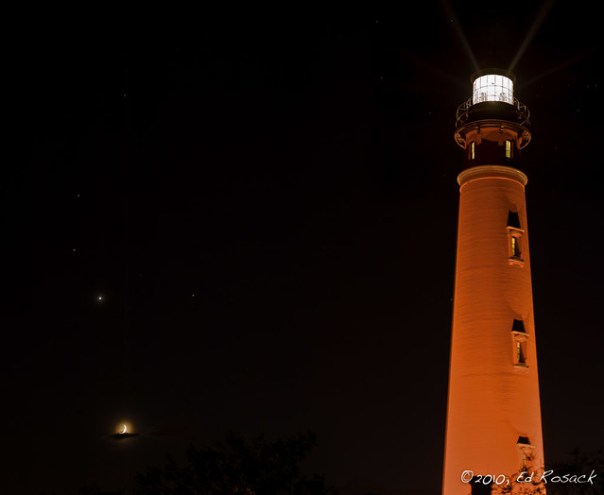Intro / Description
Happy New Year! Back to basics with my first post of 2012: A photo-op review.
When I was in the Navy, I was stationed at the Naval Ordinance Test Unit at Cape Canaveral for a while – so I’m familiar with the port and Jetty Park. But I’d never really investigated it as a photo-op. I had some time last week, and decided to visit.
Jetty Park is located on the south side of Port Canaveral in Brevard County. Depending on where you leave from, it’s a little over an hour from Orlando, basically a straight line along the Beachline Expressway (528 toll road). In addition to the jetty and 1200 foot fishing pier, there’s also a 120+ site campground and beach (with lifeguard) at the park.
Info for Photographers
Photo hints:
The rocks, pier and seaside vegetation can provide some interesting foreground for sunrise landscapes.
 The sun rises every morning…But no one know what it will look like. This was the view before dawn from the beach at Jetty Park.
The sun rises every morning…But no one know what it will look like. This was the view before dawn from the beach at Jetty Park.
You can also see a variety of shore birds. I saw Brown Pelicans, Northern Gannets, Ruddy Turnstones, Royal Terns, various Seagulls and others that I haven’t identified yet.
A place like this is also great for practicing your BIF (birds in flight) techniques. Pelicans make especially good subjects, since they tend to glide in a predictable straight line, but other birds are also flying in and around (see the last photo, below).
Tripod/Monopod:
No restrictions, so bring yours and use it.
Lenses:
This will depend on your subject. I used my tripod mounted Nikon 16 – 35mm f/4 VR Wide angle for landscapes and sunrise. When the light got a little better, I switched to hand holding my Sigma 150 – 500mm f/6.3 for birds. You can get up close to some of the birds, so a shorter telephoto might come in handy too. For example, this Brown Pelican wouldn’t fit in the field of view at 500mm. Since the bird was so still, I made a multi-shot panorama. I like to use this technique when I can since the result can be a higher resolution image (this one is 18.5 Megapixels, un-cropped).
Best time to visit:
Day visitor hours are 7am to dusk. Take this into account if you’re planning to make some sunrise photos. I didn’t and the morning I went, sunrise was at 7:15. I arrived about 6:45 and the gate was still closed, so I drove around a bit to see if there was somewhere else to make a sunrise photo (I didn’t find one). When I returned at about 6:55 they were unlocking it. I had less time than I wanted to find a good spot and setup, but I did manage to get some photos I like.
Winter is probably a good time of year to go. It’ll be less crowded (with people) and more crowded (with birds). Many of the birds could be winter visitors too.
Northern Gannet in flight: This Pelagic species is a winter migrant to the waters off of the Florida coast.
Other:
There’s a $10 per day usage / parking fee.
The morning I was there I saw a young man land a large fish from the end of the pier. This might be a good place to combine your interest in fishing, camping and the beach with a photo side excursion.
There’s a lot of shipping activity at the port. Cruise ships and fishing boats enter and leave regularly. I think you can still occasionally see a submarine that’s visiting too.
Jetty park is close to both Viera Wetlands and Merritt Island National Wildlife Refuge. If you have time for a little longer trip, you could combine a visit here with a second stop at one of those places. The morning I went, I also stopped by Viera to see what was going on there.
Summary
I added a few birds to my life list and a few photos I really like to my archives. You can too. Check out the other photos I made there in this set on Flickr. Let me know how your visit to the park goes.
| My Gallery / Flickr photo set: | http://www.flickr.com/photos/edrosack/sets/72157628638922015/with/6606239041/ |
|---|---|
| Their Website: | http://www.portcanaveral.com/recreation/beaches.php |
| Address / Phone: | 9035 Campground Cir, Cape Canaveral, FLView in Google Maps |
| Central Florida Photo Ops Rating: | A sunrise and shorebird showplace! |
Thanks for stopping by and reading my blog. Now – go make some photos!
©2012, Ed Rosack. All rights reserved.















































